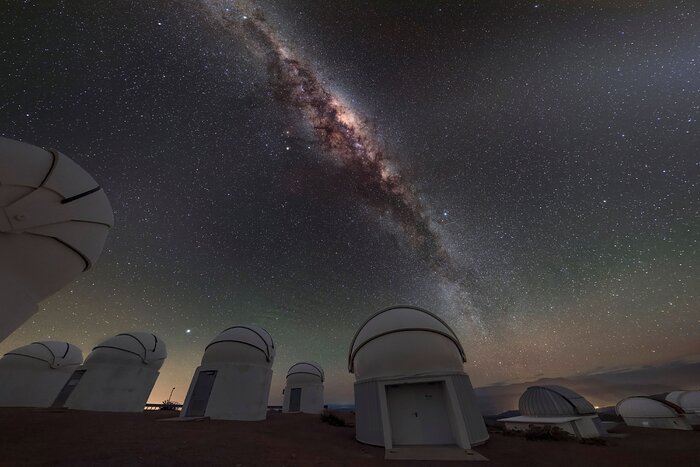El corazón de la Vía Láctea
El centro de la Vía Láctea brilla con tonalidades rojas-amarillentas, similar a un "corazón", en un efecto invisible a los ojos logrado gracias a esta fotografía de larga exposición tomada en el Observatorio Interamericano Cerro Tololo (CTIO), un programa del Laboratorio NOIRLab de NSF. El centro de nuestra galaxia sólo es visible desde el hemisferio Sur y las áreas cercanas al Ecuador (como Hawaiʻi) debido a la orientación de la Tierra. Gracias a su ubicación en las montañas del Norte de Chile, CTIO hace que los cielos del Sur sean accesibles para los astrónomos estadounidenses. Además de albergar grandes telescopios de investigación, CTIO se adapta a una variedad de observatorios de inquilinos más pequeños. Las pequeñas cúpulas que pueblan la esquina inferior izquierda de esta imagen pertenecen a PROMPT, uno de esos observatorios de arriendo. Como su nombre lo indica, estos telescopios están diseñados para observaciones rápidas que prestan soporte a la Astronomía de dominio de tiempo, en particular para observar las secuelas de los estallidos de rayos gamma, explosiones tremendamente poderosas y distantes que pueden durar sólo fracciones de segundo. Al lado derecho de la imagen se encuentra el telescopio de 1,3 metros del consorcio SMARTS, y también parte de los telescopios del Observatorio Las Cumbres, son visibles en la imagen.
Créditos:CTIO/NOIRLab/NSF/AURA/B. Tafreshi
About the Image
| Id: | iotw2020a |
| Idioma: | es |
| Tipo: | Photographic |
| Release date: | 13 de Mayo de 2020 a las 03:00 |
| Size: | 10980 x 7320 px |
Sobre el Objeto
| Categoría: | CTIO |
